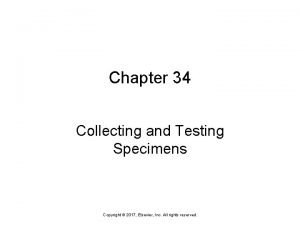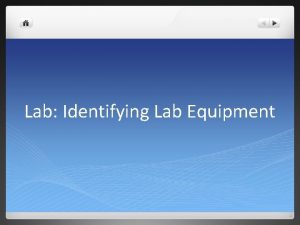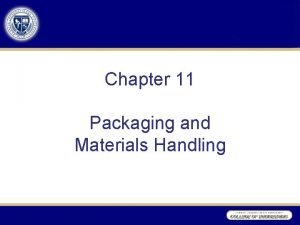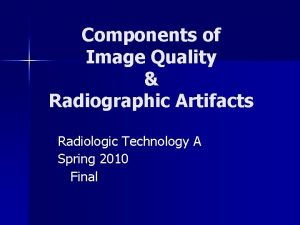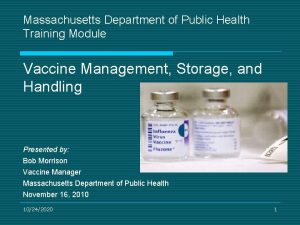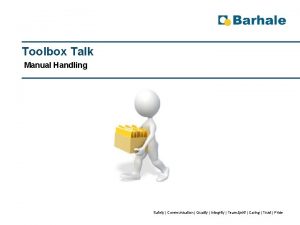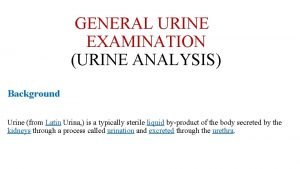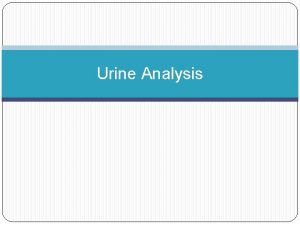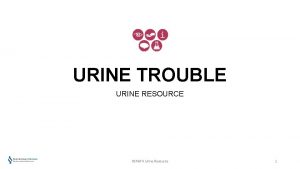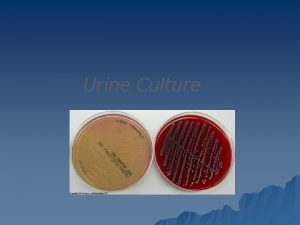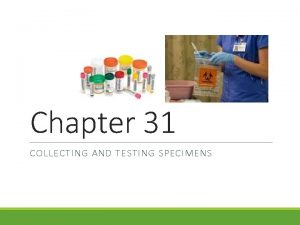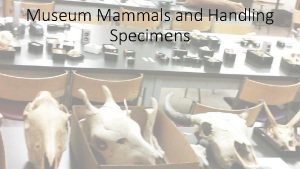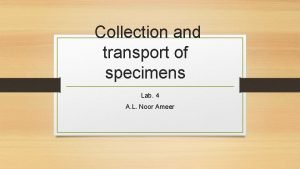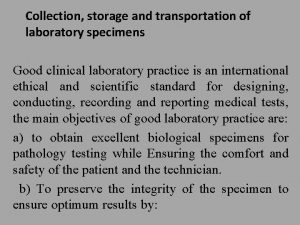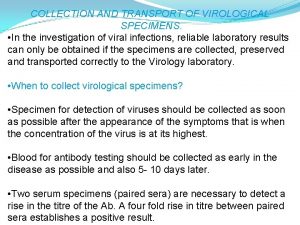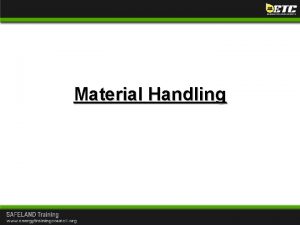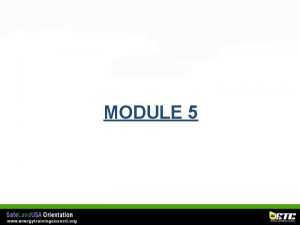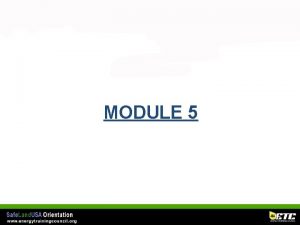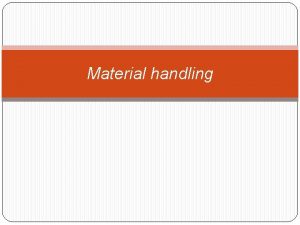Collection and Handling of Urine Specimens n Urine



































- Slides: 35


Collection and Handling of Urine Specimens n Urine has a long, rich history as a source for measuring health and well -being and remains an important tool for clinical diagnosis. The clinical information obtained from a urine specimen is influenced by the collection method, timing and handling.

Collection and Handling of Urine Specimens n A vast assortment of collection and transport containers for urine specimens are available. Determining which urine collection method and container should be used depends on the type of laboratory test ordered.

Types Of Urine Collection n Laboratory urine specimens are classified by the type of collection conducted or by the collection procedure used to obtain the specimen.

Types Of Urine Collection n Random Specimen This is the specimen most commonly sent to the laboratory for analysis, primarily because it is the easiest to obtain and is readily available. This specimen is usually submitted for urinalysis and microscopic analysis, although it is not the specimen of choice for either of these tests.

Types Of Urine Collection n specimens can sometimes give an Random inaccurate view of a patient's health if the specimen is too diluted analyte values are artificially lowered. Pediatric specimens, which routinely undergo chemistry and microscopic analysis, are generally of this type.

Types Of Urine Collection n As the name implies, the random specimen can be collected at any time. Although there are no specific guidelines for how the collection should be conducted, avoiding the introduction of contaminants into the specimen is recommended. This requires explicit instructions to patients so that they do not touch the inside of the cup or cup lid.

Types Of Urine Collection n First Morning Specimen This is the specimen of choice for urinalysis and microscopic analysis, since the urine is generally more concentrated (due to the length of time the urine is allowed to remain in the bladder) and, therefore, contains relatively higher levels of cellular elements and analytes such as protein, if present.

Types Of Urine Collection n Also called an 8 -hour specimen, the first morning specimen is collected when the patient first wakes up in the morning, having emptied the bladder before going to sleep.

Types Of Urine Collection n Since the urine can be collected over any eight-hour period, collection is practical for patients who have atypical work/sleep schedules. Proper collection practices and accurate recording of the collection time are important criteria of a first morning specimen. Note: Any urine that is voided from the bladder during the eight-hour collection period should be pooled and refrigerated, so that a true 8 -hour specimen is obtained.

Types Of Urine Collection n Midstream Clean Catch Specimen This is the preferred type of specimen for culture and sensitivity testing because of the reduced incidence of cellular and microbial contamination. Patients are required to first cleanse the urethral area with a castile soap towelette.

Types Of Urine Collection n The patient should then void the first portion of the urine stream into the toilet. These first steps significantly reduce the opportunities for contaminants to enter into the urine stream.

Types Of Urine Collection n The urine midstream is then collected into a clean container (any excess urine should be voided into the toilet). This method of collection can be conducted at any time of day or night.

Types Of Urine Collection n Catheter Collection Specimen This assisted procedure is conducted when a patient is bedridden or cannot urinate independently. The healthcare provider inserts a foley catheter into the bladder through the urethra to collect the urine specimen.

Types Of Urine Collection n )Specimens may also be collected through an existing foley catheter. ) Specimens may be collected directly from a foley into an evacuated tube or transferred from a syringe into a tube or cup.

Types Of Urine Collection n Suprapubic Aspiration Specimen This method is used when a bedridden patient cannot be catheterized or a sterile specimen is required. The urine specimen is collected by needle aspiration through the abdominal wall into the bladder.

Types Of Urine Collection n Pediatric Specimen For infants and small children, a special urine collection bag is adhered to the skin surrounding the urethral area. Once the collection is completed, the urine is poured into a collection cup or transferred directly into an evacuated tube with a transfer straw. Urine collected from a diaper is not recommended for laboratory testing since contamination from the diaper material may affect test results.

Types Of Urine Collection n 24 -Hour Urine Collections The Laboratory Services provides 24 -hour urine collection containers with various types of preservatives depending on the test requested. It is recommended that all timed urine collections (24 hours) be kept refrigerated during the collection period and brought to the laboratory as soon as possible after completion. Please refer to our urine preservative chart for specific information.

Use the following procedure for the correct specimen collection and preparation : 1 - Warn the patient of the presence of potentially hazardous preservatives in the collection container. 2 - Instruct the patient to discard the first morning specimen and to record the time of voiding. 3 - The patient should collect all subsequent voided urine for the remainder of the day and night. 4 - On the second day, collect the first morning specimen at the same time as noted on day one. This void completes the 24 -hour collection.

Urine Collection Products n There are many different manufacturers of urine collection containers. Information on a specific product's uses, features and claims should be obtained from that device's manufacturer.

Urine Collection Products n Urine Collection Containers (cups for collection and transport) Urine collection container cups come in a variety of shapes and sizes with lids that are either snap on or screw on. To protect healthcare personnel from exposure to the specimen and protect the specimen from exposure to contaminants, leak- resistant cups should be utilized.

Urine Collection Products n Some urine transport cup closures have special access ports that allow closed-system transfer of urine directly from the collection device to the tube.

Urine Collection Products n Urine Collection Containers (24 -hour collection) Urine collection containers for 24 -hour specimens come in a variety of shapes and colors, but most are of 3 liter (L) capacity 1 and are amber colored (to protect light-sensitive analytes such as porphyrins and urobilinogen). Closure types vary and some have a port for ease of specimen transfer into a tube. When a preservative is required, it should be added to the collection container before the urine collection begins and warning labels should be placed on the container.

Urine Collection Products n If there is more than one acceptable preservative for the analyte being tested, the least hazardous one should be selected. A corresponding Material Safety Data Sheet (MSDS) should be given to the patient, and the healthcare provider should explain any potential hazards. Some common 24 -hour preservatives are hydrochloric acid, boric acid, acetic acid and toluene.

Urine Collection Products n Urinalysis Tubes Urine specimens are poured directly into urinalysis tubes with screw- or snap-on caps. Additionally, there are evacuated tubes similar to those used in blood collection that are filled by using a straw device, from cups with integrated transfer devices built into their lid, or from direct sampling devices that are used to access catheter sampling ports. Urinalysis tubes come in an array of tube shapes: conical bottom, round bottom, or flat bottom.

Urine Collection Products n Conical bottom tubes provide the best sediment collection for microscopic analysis. Some tubes are specially designed to be used with a pipetter that allows for standardized sampling. The tubes you select should be able to withstand centrifugation and, if used with an automated instrument system, should be compatible with the corresponding racks and carriers. Fill volumes of urinalysis tubes usually range from 8 to 15 m. L.

Specimen Collection and Transport Guidelines n As with any type of laboratory specimen, there are certain criteria that need to be met for proper collection and transportation of urine specimens. This will ensure proper stability of the specimen and more accurate test results.

Specimen Collection and Transport Guidelines n n All urine collection and/or transport containers should be clean and free of particles or interfering substances. The collection and/or transport container should have a secure lid and be leakresistent. Leak-resistent containers reduce specimen loss and healthcare worker exposure to the specimen while also protecting the specimen from contaminants.

Specimen Collection and Transport Guidelines n n It is good practice to use containers that are made of break-resistant plastic, which is safer than glass. The container material should not leach interfering substances into the specimen. Specimen containers should not be reused. Transport tubes should be compatible with automated systems and instruments used by the lab.

Urine Specimen Handling Guidelines n Labels Include the patient name and identification on labels. Make sure that the information on the container label and the requisition match. If the collection container is used for transport, the label should be placed on the container and not on the lid, since the lid can be mistakenly placed on a different container. Ensure that the labels used on the containers are adherent under refrigerated conditions.

Urine Specimen Handling Guidelines n Volume Ensure that there is sufficient volume to fill the tubes and/or perform the tests. Underfilling or overfilling containers with preservatives may affect specimen-to -additive ratios.

Urine Specimen Handling Guidelines n Collection Date and Time Include collection time and date on the specimen label. This will confirm that the collection was done correctly. For timed specimens, verify start and stop times of collection. Document the time at which the specimen was received in the laboratory for verification of proper handling and transport after collection.

Urine Specimen Handling Guidelines n Collection Method The method of collection should be checked when the specimen is received in the laboratory to ensure the type of specimen submitted meets the needs of the test ordered. An example of an optimum specimen/test match would be a first morning specimen for urinalysis and microscopic examination.

Urine Specimen Handling Guidelines n Light Protection Verify that specimens submitted for testing of light-sensitive analytes are collected in containers that protect the specimen from light. This is a glimpse into the complexity of proper urine collection and handling. Since a variety of urine collection procedures and applications exist today, it becomes critical to understand how, when and where things can go wrong.

Urine Specimen Handling Guidelines n As the trend toward more home-based testing and less invasive methods continues, urine will become one of the most useful specimen types collected for clinical assessment.
 Chapter 34 collecting and testing specimens
Chapter 34 collecting and testing specimens Why do we make use of contrived experiences?
Why do we make use of contrived experiences? Dari hasil tes ternyata urine pak jaka mengandung glukosa
Dari hasil tes ternyata urine pak jaka mengandung glukosa Hand lens
Hand lens Which laboratory tools can be used to magnify small objects
Which laboratory tools can be used to magnify small objects Dissection safety video
Dissection safety video Nurses responsibility in collection of urine specimen
Nurses responsibility in collection of urine specimen Landsat collection 1 vs collection 2
Landsat collection 1 vs collection 2 Documentary collection
Documentary collection Materials handling and storage ppt
Materials handling and storage ppt Protective packaging and materials handling
Protective packaging and materials handling Material handling objectives
Material handling objectives Wendylett sheets 1 carer
Wendylett sheets 1 carer Hydrilla cell diagram
Hydrilla cell diagram Classification of fisheries
Classification of fisheries Handling information in health and social care
Handling information in health and social care Radiographic artifacts definition
Radiographic artifacts definition Chapter 20:3 puncturing the skin to obtain capillary blood
Chapter 20:3 puncturing the skin to obtain capillary blood Care of library materials
Care of library materials Informer recruitment
Informer recruitment Camera handling care and support
Camera handling care and support Vaccine storage and handling sop worksheet
Vaccine storage and handling sop worksheet Manual handling competency assessment form
Manual handling competency assessment form Material handling and facilities planning
Material handling and facilities planning Vaccine storage and handling protocol
Vaccine storage and handling protocol Manual handling toolbox talk presentation
Manual handling toolbox talk presentation Post harvest handling of cut flowers and greens
Post harvest handling of cut flowers and greens Mechanical and remote handling
Mechanical and remote handling N
N Male genital
Male genital Acute fulminating preeclampsia
Acute fulminating preeclampsia Urinary system
Urinary system Kidney failure and foamy urine pictures
Kidney failure and foamy urine pictures Pathology of blood and urine ppt
Pathology of blood and urine ppt What is an objection in sales
What is an objection in sales Web handling basics
Web handling basics
